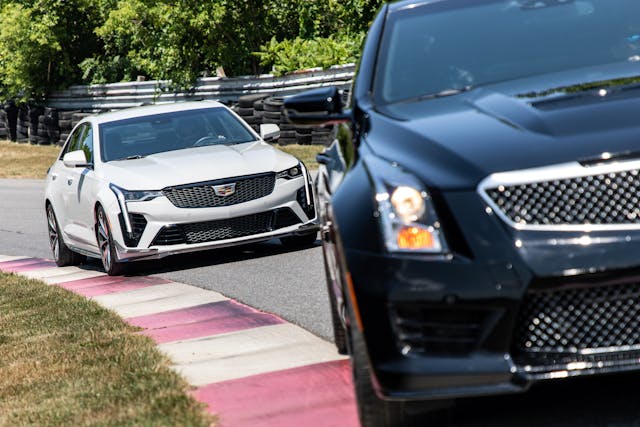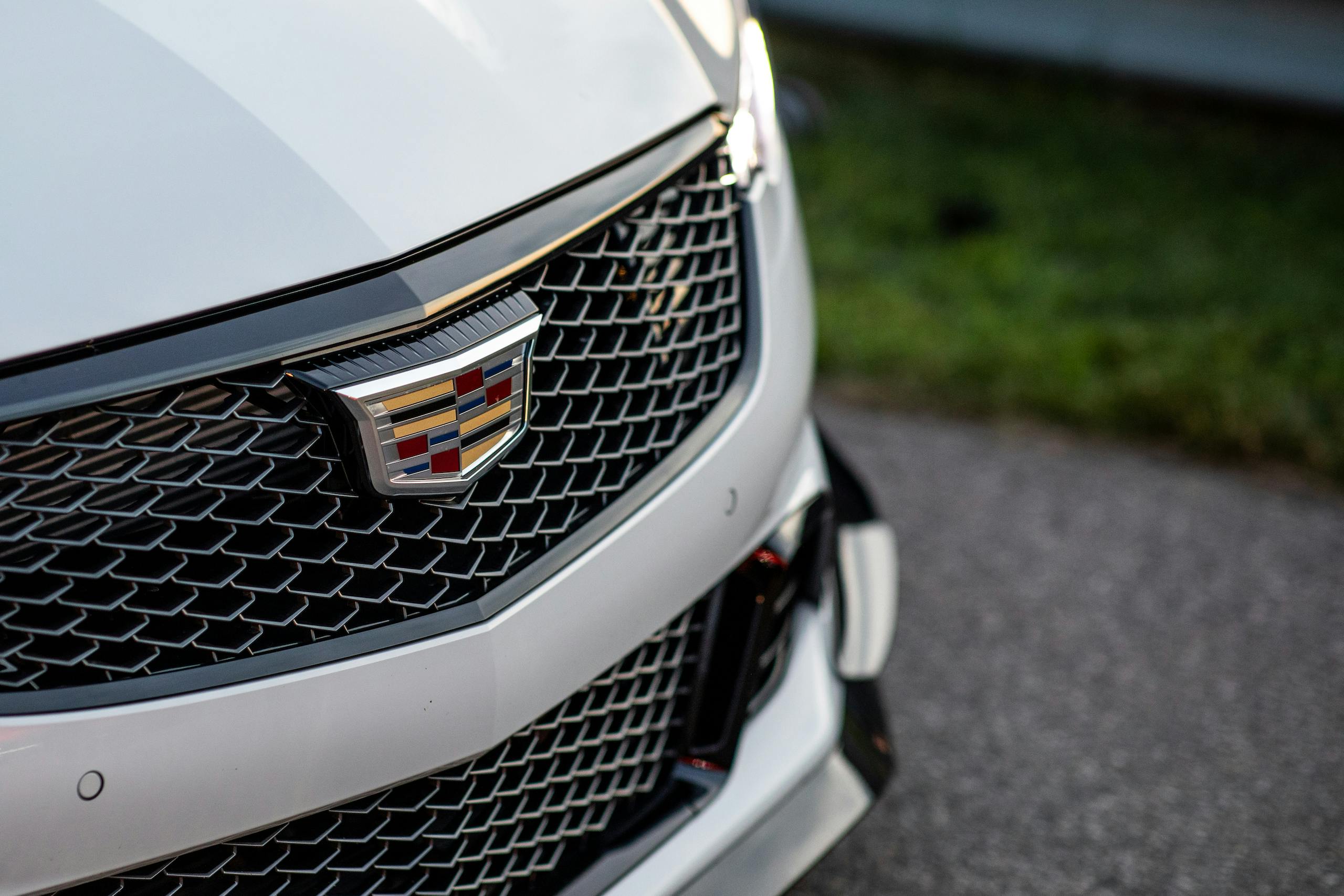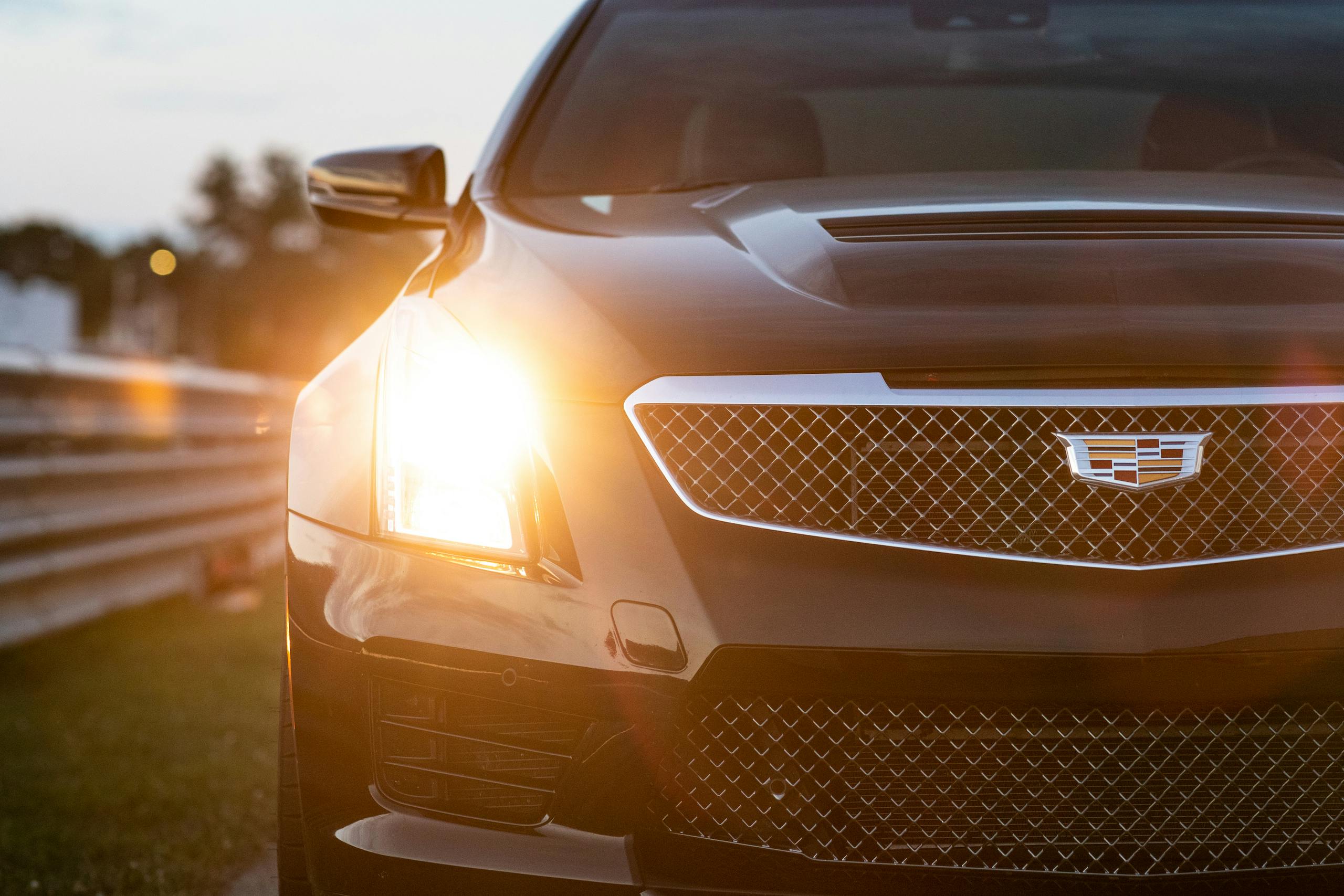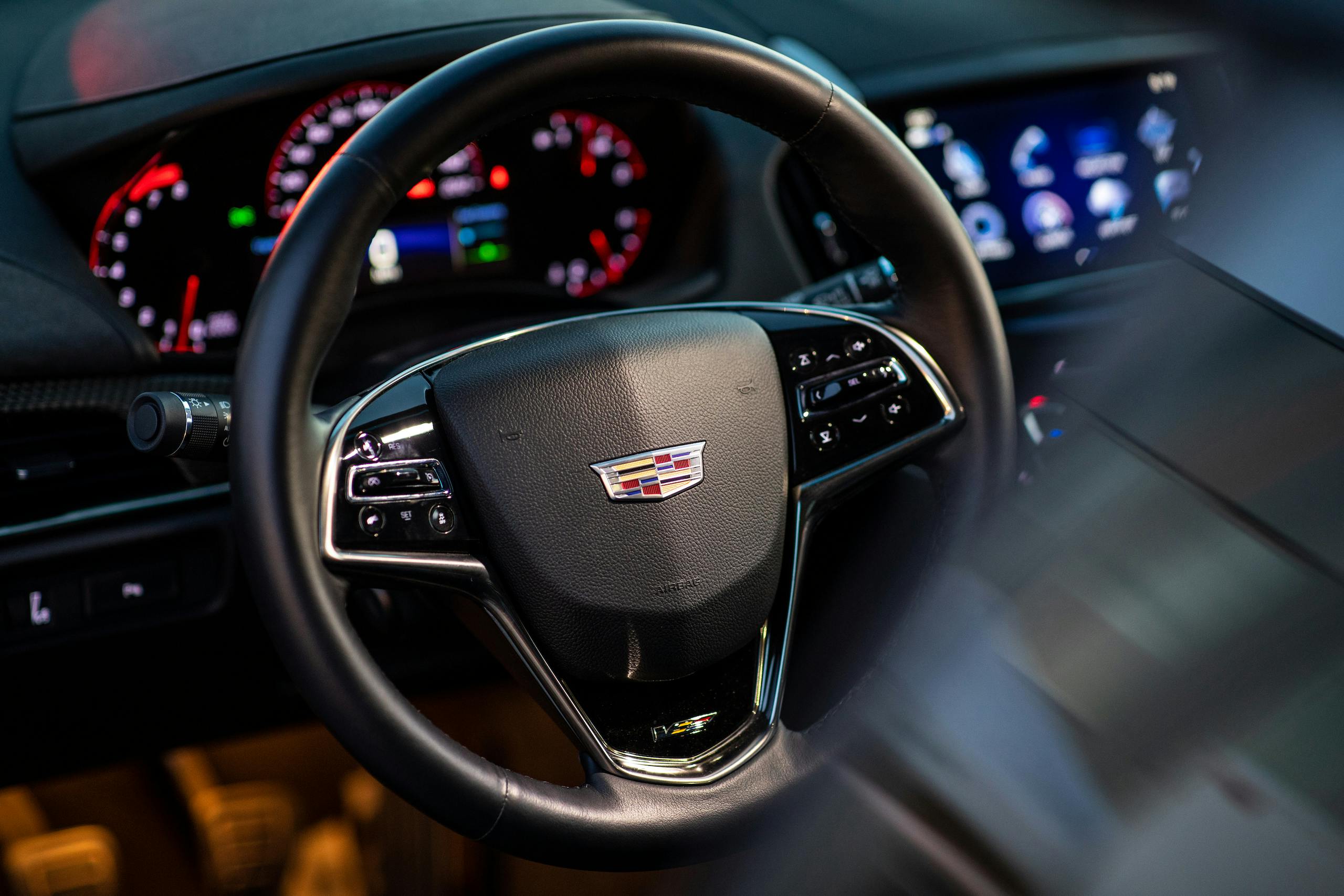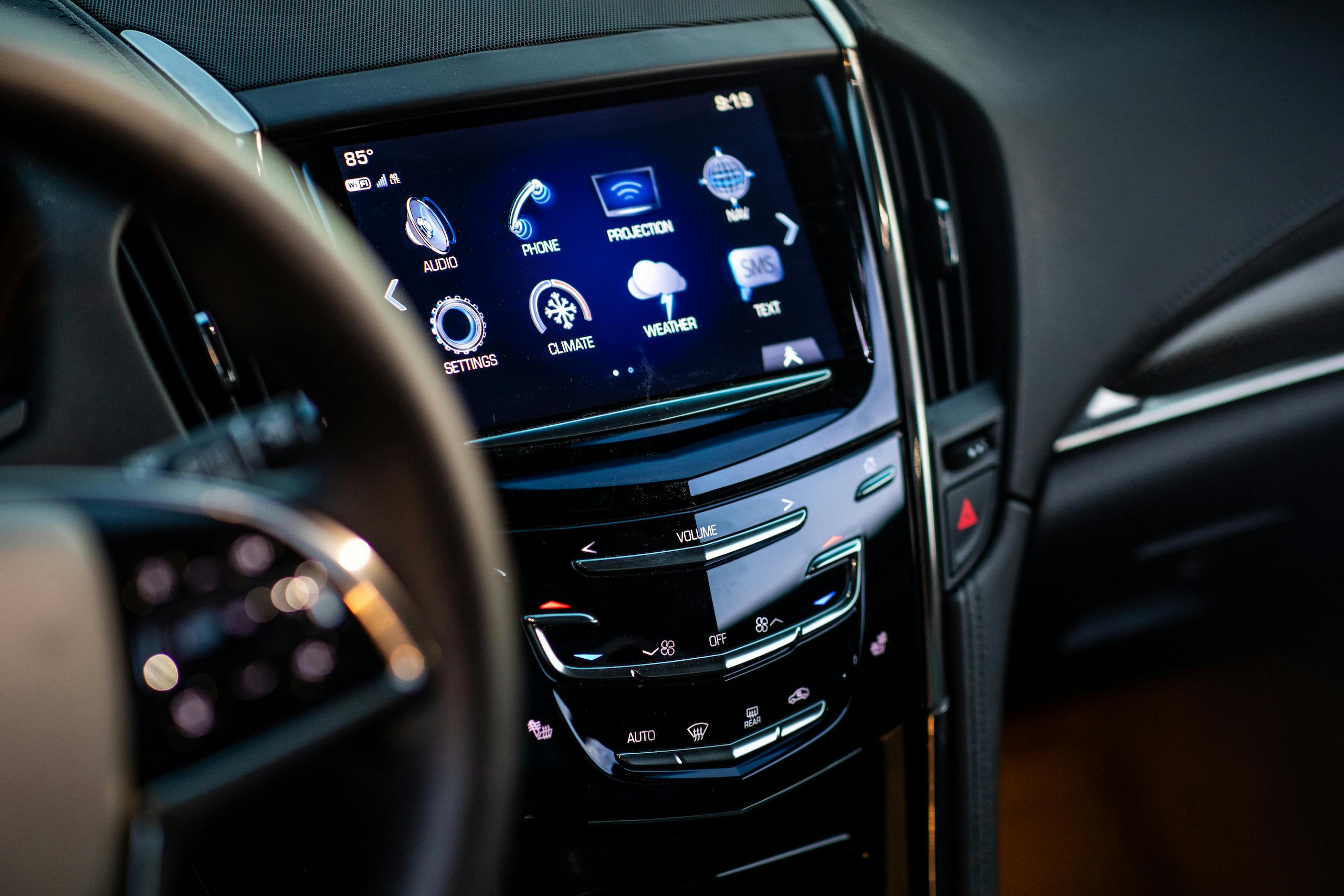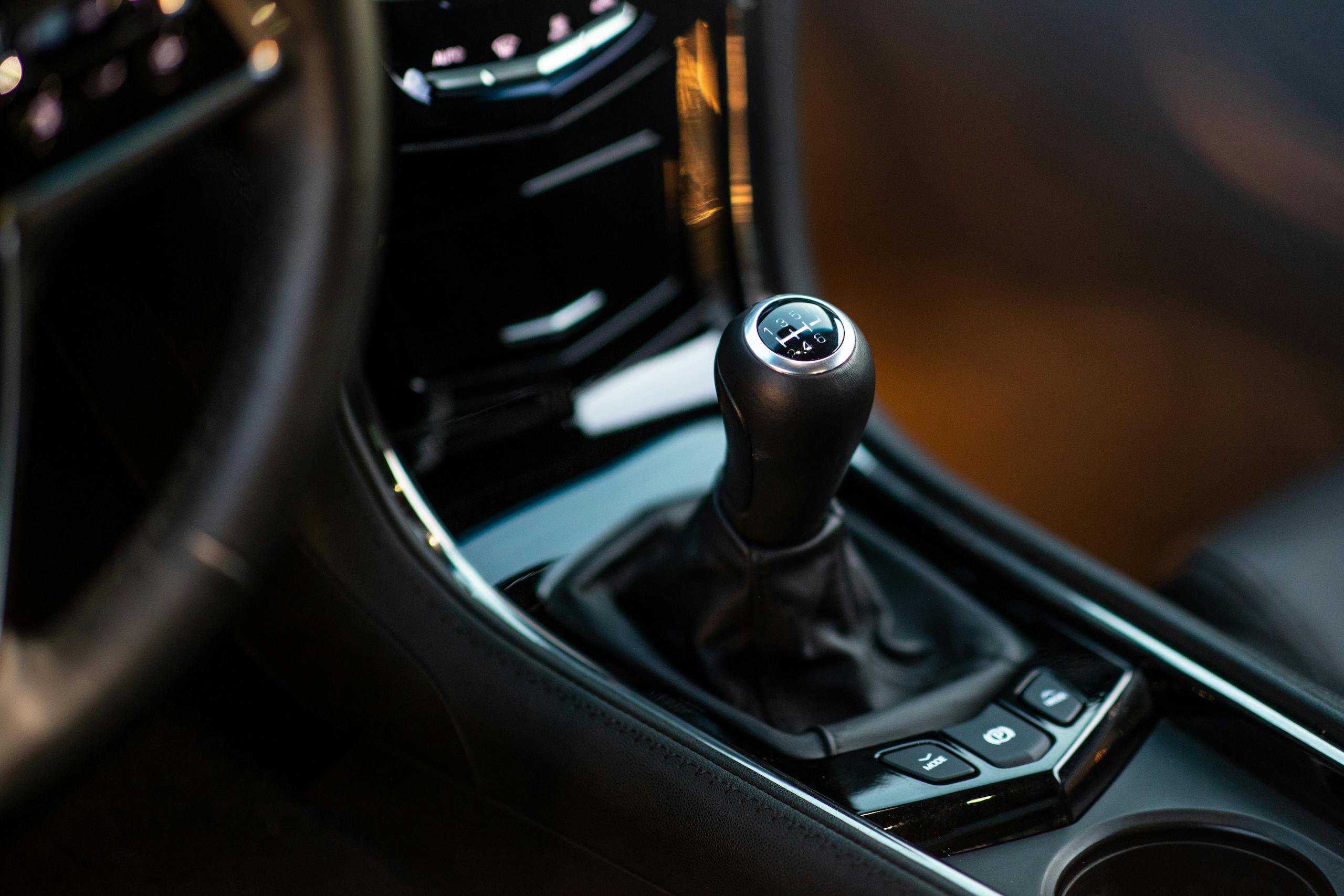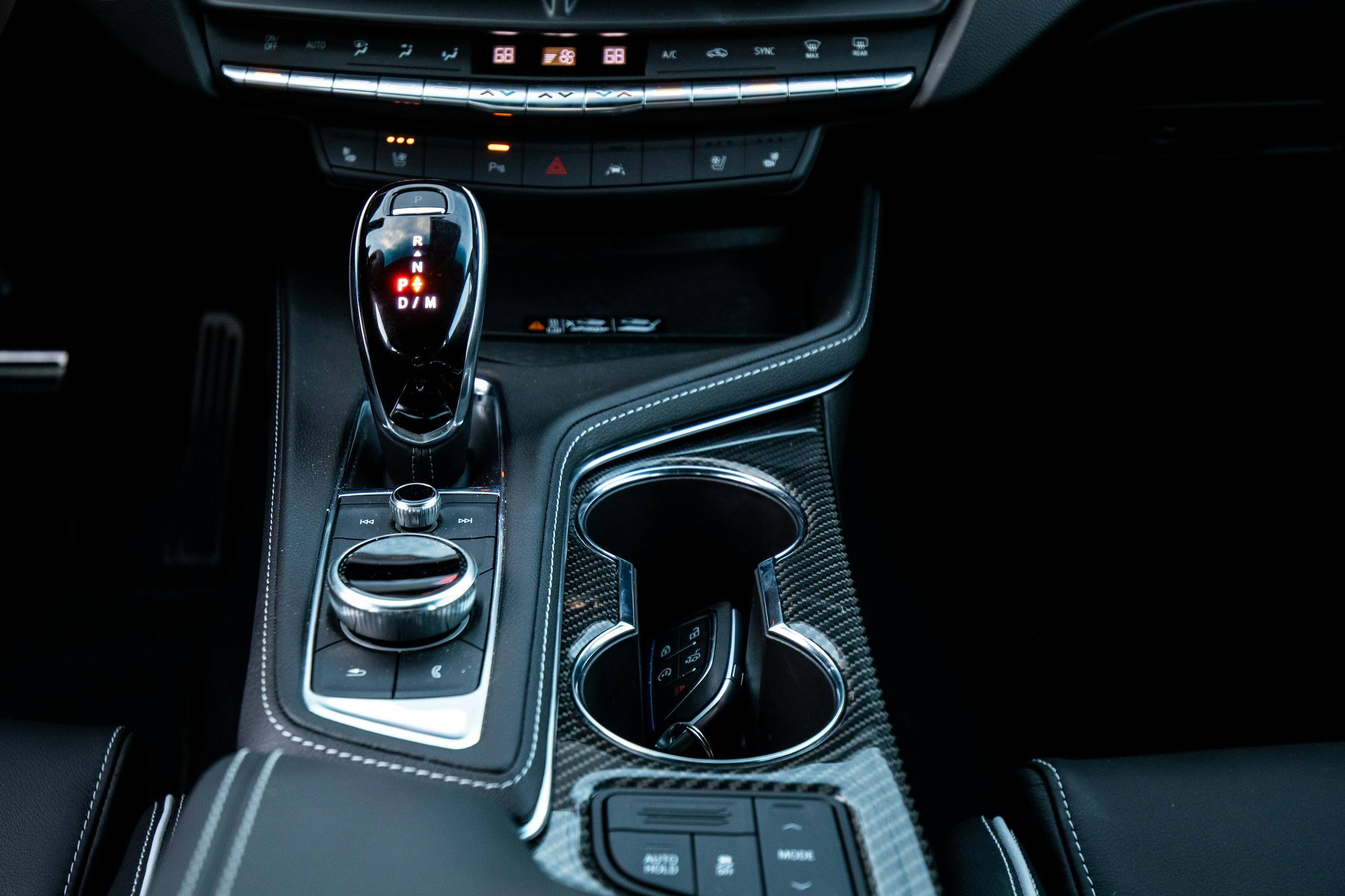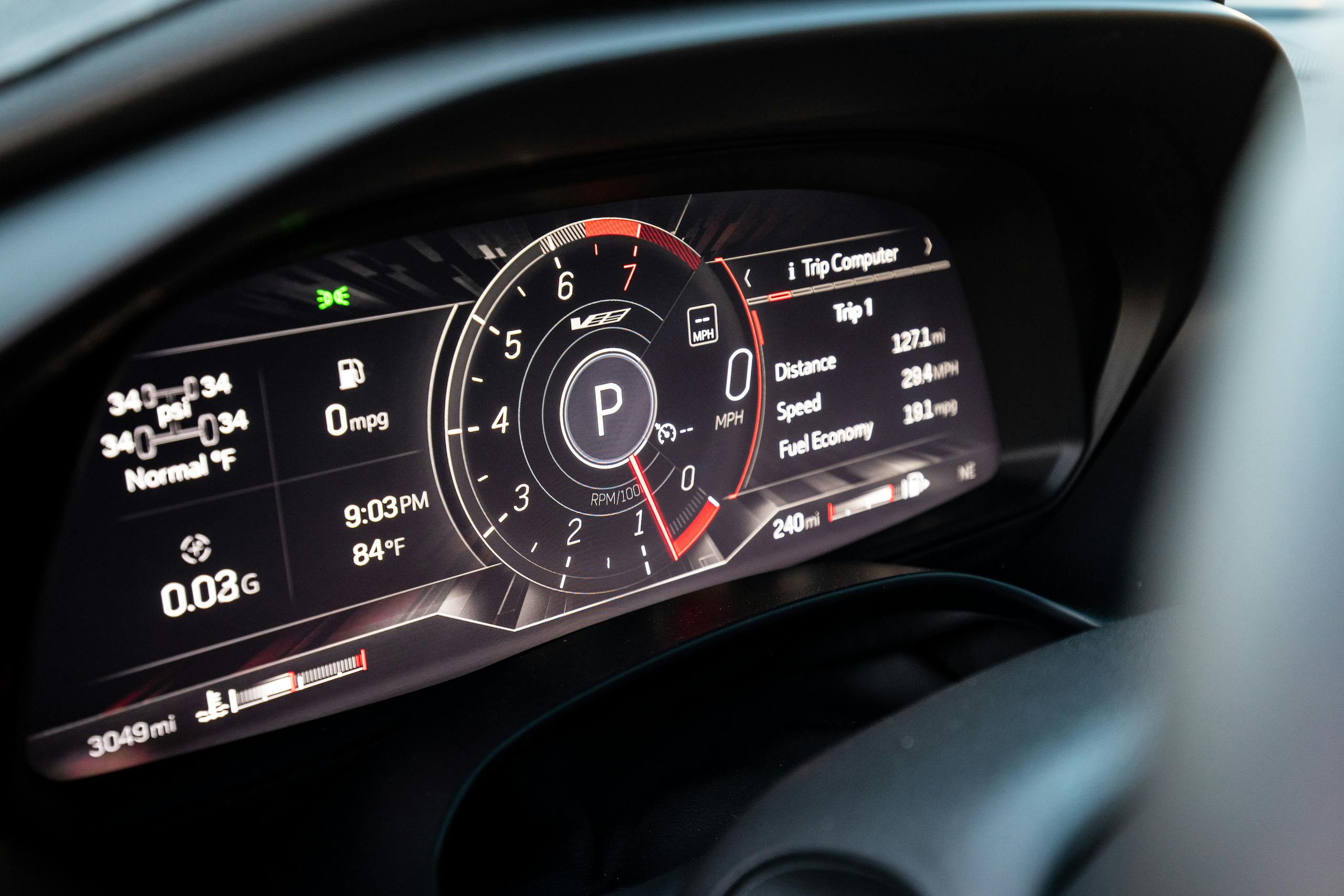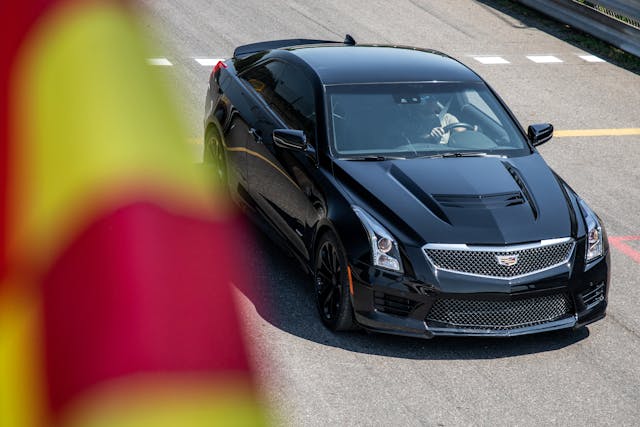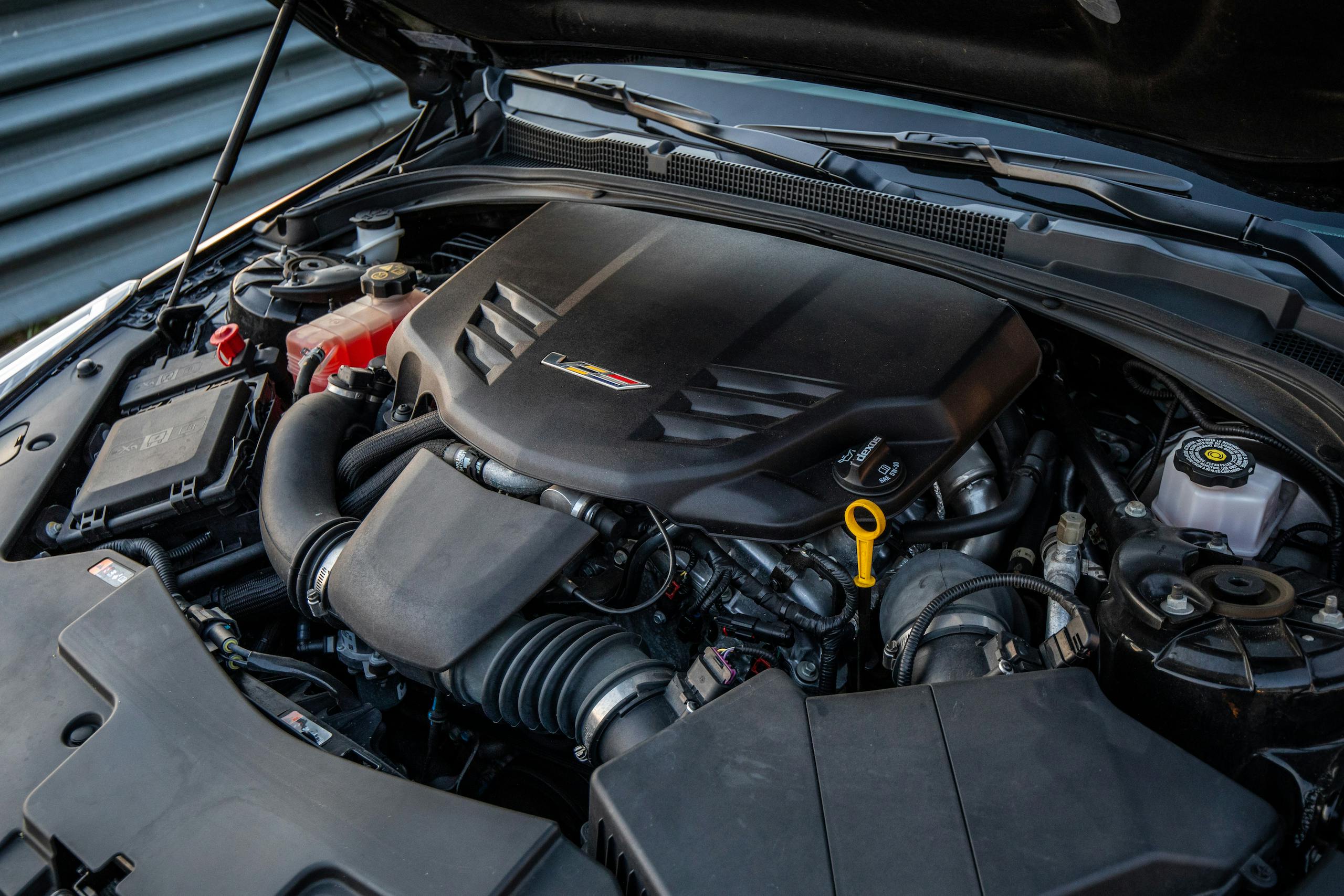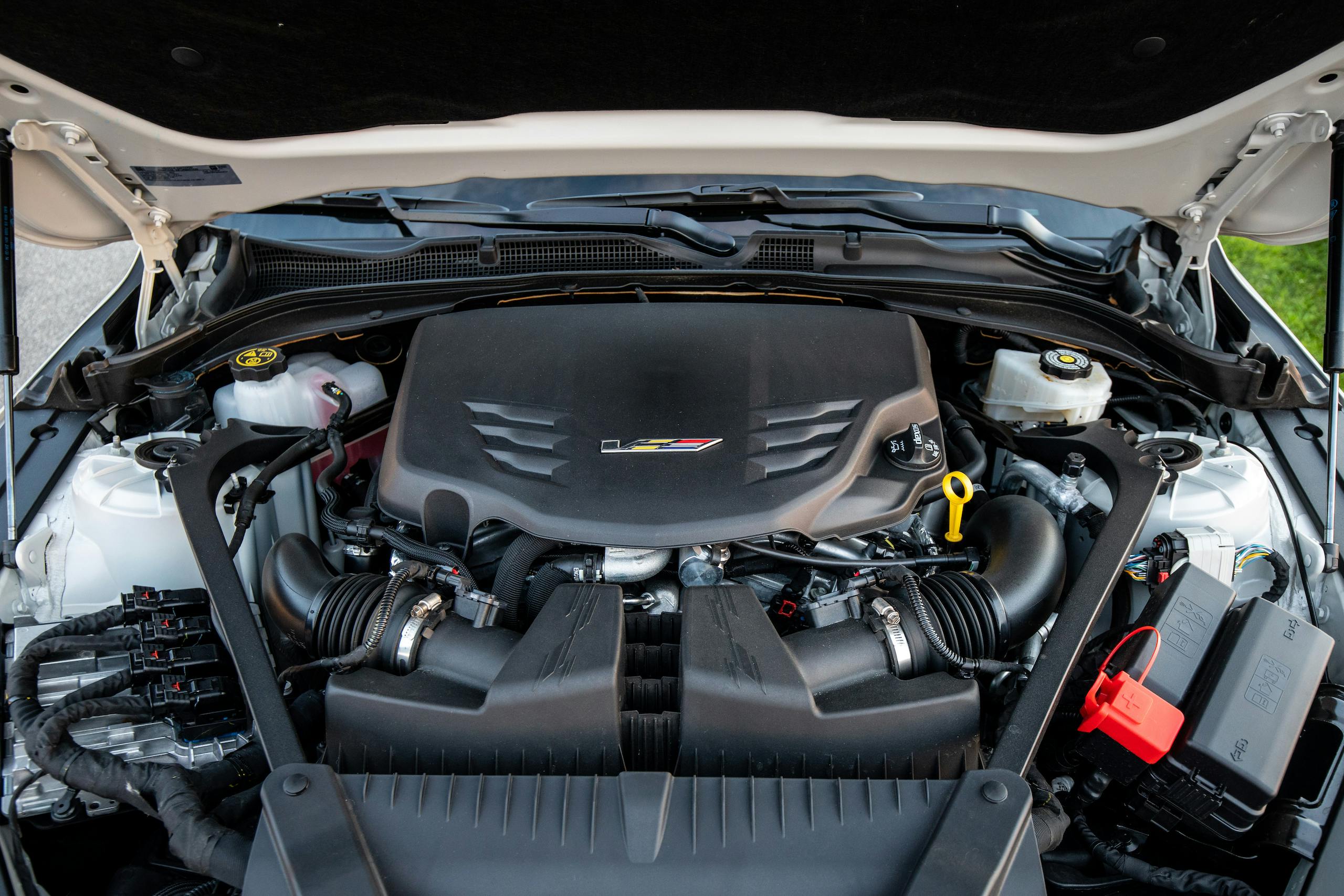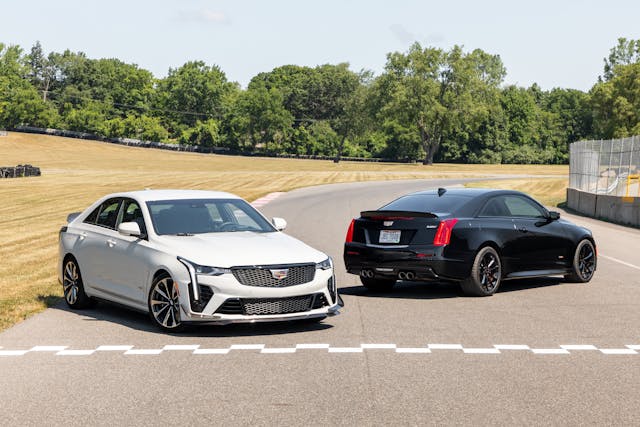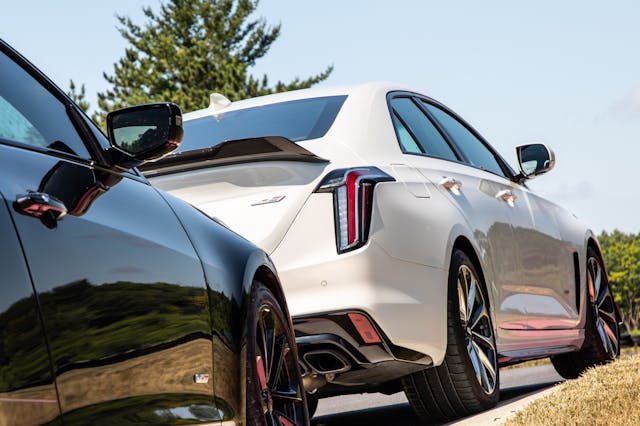By Eddy Eckart / Hagerty.com
The CT4-V Blackwing kept asking to be pushed harder. A poised chassis, grip for ages, and sharp, communicative steering encouraged me to crank up the bravery with every turn. Miles of short straights and varied-radius corners that often expose the worst in a chassis instead brought out the best in this one. This much fun makes you forget that Cadillac will never build a car like this again.
Sedans, out. Gas engines, out. Electrification, in. That’s about as succinct as we can put it. With the CT4-V Blackwing, and its big brother the CT5-V Blackwing, Cadillac’s quest to build the perfect sports sedans has reached its final chapter. “At end of day, we want to walk away and say that this was the best driver’s sedan ever created,” said Brandon Vivian, Executive Chief Engineer at Cadillac of the 4-V Blackwing. Every PR person says something along those lines, but Vivian is no flack. He’s one of the no-nonsense masterminds who’ve been a part Cadillac’s performance team for years. He is also a dedicated racer. After a day hammering the CT4-V Blackwing, I understand why Vivian is so proud of the final product.
Of course, I’m biased. I must cop to owning the Blackwing’s predecessor, the ATS-V pictured here. It’s a 2017 manual-transmission coupe. For the 4-V Blackwing, Cadillac engineers specifically benchmarked the ATS-V rather than any outside competition, so it’s the perfect foil by which to measure the new car’s changes.
The Blackwing twins are the culmination of nearly twenty years of Cadillac trying to prove its chassis dynamic prowess. You may recall that V-series began chasing sport sedan supremacy with the 2004 CTS-V as part of an effort to build a new performance-focused identity for Cadillac. Subsequent generations stormed the Nürburgring with brawny, supercharged V-8s, and the Cadillac V-series was suddenly being discussed in same breath as Mercedes-AMG and BMW M. The ATS-V debuted in 2016 as a driver-oriented sport sedan unabashedly gunning for the M3. Contemporary reviews knocked its interior packaging and overall quality, but the car’s acclaim as a potent track or canyon-carving sedan was near-unanimous.
Unfortunately, by the time the Caddy proved its mettle with the ATS-V, the bottom had begun to fall out of the sedan market at large. Once crossover sales were crushing sedans in showrooms, no one would have blamed Cadillac for pulling the plug on gas-powered performance four-doors. Even Cadillac recognizes that the 4-V Blackwing won’t set sales figures alight; there’s a numbered plaque on each one. That’s in part an acknowledgment of what makes these cars so special. Cadillac built these cars because it wanted to, and because there are still just enough of us out here that understand and appreciate them. Amid an industry-wide shift toward EVs and too-tall wagons, that window is closing fast.
No time like the present, right? To taste just how far the 4-V Blackwing has come, we brought it together with my ATS-V for a romp on Michigan back roads. How do the Cadillac’s team’s changes—and there are many—set the new car apart? Are we to believe Vivian’s bold claim that this is “the best driver’s sedan ever created?”
Having covered about 6000 miles of street and some limited track driving at GingerMan Raceway in my ATS-V, I had a pretty good feel for that car as a baseline going into our drive. I handed my key to Executive Editor Eric Weiner and hopped inside the white-silver (Rift Metallic) Blackwing.
Hail the return of actual buttons to Cadillac interiors! I went into my ATS-V purchase in 2020 knowing full well that despite the sumptuous chassis I’d have make do with the car’s infamous CUE infotainment system, complete with temperamental haptic buttons and a volume slider. Daily life with it is not so bad; most of the time you get in, set the auto climate control, turn on music from your phone, and leave it alone. I’m no stranger to sacrifices in pursuit of sporting enjoyment: I ignore the runny headlights on my 986 Boxster because I love how it sounds and clings to a corner. No such negotiation applies in the Blackwing. Cadillac’s return to a dash with quickly accessible, easy-to-use buttons and knobs is cleaner and more functional to boot. “Good riddance, CUE,” were Weiner’s first words after landing back in the ATS, a car he’d last driven in 2017. “I do miss the plushness of these seats, though.”
The new seats are quite a bit firmer than the ATS-V’s Recaros, but the Blackwing’s 14-way adjustable chairs willingly contorted to meet my preferences. Both can squeeze you laterally as tight as you please, and I appreciated the extensive lumbar range in the newer car. Weiner contended the Blackwing’s were better for spirited driving, but he appreciated the more substantial padding in the V for longer trips.
Atop the steering wheel is wrapped a red leather stripe, subtly suggesting that, just maybe, driving the Blackwing could induce you into some opposite-lock misbehavior. Beyond the refreshingly higher-quality leather airbag cover sits a configurable, easy-to-read full digital display. The controls are purposeful and ergonomic—nothing distracts.
Once we were rolling, it wasn’t a mile before I noticed considerable differences in the Blackwing. It came through my hands at first: the 4-V’s road feedback felt incrementally clearer and sharper than what the already excellent ATS-V rack offers. Think about when HDTVs went from 780p to 1080p—the added clarity is subtle but it’s there. The engineers replaced the plastic and rubber components from the steering column with metal pieces, removing isolating elements between the driver and the road. After sampling all the steering settings, I felt this added sharpness paired better with heavier weighting, even if I was simply tooling along. The increased effort of the sport-oriented modes balanced the steering’s more eager nature.
Precision is the refrain in this little Blackwing’s song. While Cadillac’s dampers often steal the show, it was the mechanical changes to the suspension that I perceived most. A flowing right-hander at the beginning of our route revealed reduced body motion. Roll, and it turns out dive as well, are significantly tamped, owing to stiffer sway bars (17 percent up front, 27 percent out back) and springs (13 percent front, 10 percent rear). The car plants itself more quickly and confidently, and that’s where you start to appreciate how the stiffer hardware works in concert with those fantastic magnetorheological dampers.
Software and hardware revisions enable the mag-ride dampers to react faster as well as more effectively communicate with other facets of the car, like the steering and that excellent updated electronically-actuated clutch-type differential. Because the system actively works in the background, it’s a bit of a challenge to say how much better the evolved dampers and system integration is over the ATS-V. You have to look at the end product rather than its individual parts. Both are incredibly composed vehicles, but the Blackwing is clearly more stable while simultaneously more eager to respond to driver inputs, and it couldn’t achieve that without advancements in its black-box tech.
There’s also plenty in the way of old-school chassis improvement here. A new rear cradle, stiffer rear knuckles, lighter top hats and control arms, and revised bushings throughout complement a stiffer unibody. It’s enough of a change that Cadillac calls the chassis underpinning this Blackwing “Alpha 2.0,” versus the original Alpha platform engineered for the ATS, CTS, and the Chevy Camaro. Like the software integration improvements, these structural updates present themselves in the overall experience rather than in isolation. I’d be hard-pressed to say the Blackwing felt structurally stiffer than the ATS-V despite the substantively sharpened driving characteristics.
More so than the ATS-V, the new car begs for personalization. Steering, exhaust, dampers, brakes, Performance Traction Management (GM’s adjustable performance-oriented stability and traction control) modes: it’s all there for you to tailor to your specific liking. Each of the default driving modes is plenty capable, and if you didn’t have the individual options you’d be perfectly happy popping between the basic settings. There’s a whole generation of us that fiddled with cars on Forza or Gran Turismo, hoping to optimize our ride for each circuit, and now we get to do the same on the long way home from work.
The Blackwing makes fine tuning a lot easier than the ATS-V, which itself is pretty much a set-and-forget scenario. For me, it’s Touring for docile driving and Track mode, Performance Traction Management setting three or four (traction control off and reduced yaw control) when I’m feeling assertive. In the new car, you now have a knob on the steering wheel to quickly toggle among modes, including your own individual setting, rather than having to dive deeper into menus and double tapping the traction control button.
Perhaps because it’s the latest addition, the adjustable brake feel captured my attention most. On its softest setting, the pedal remains sporty-articulate and does a good job of letting you modulate pressure. Switching to full firm doesn’t make it grabby by any stretch, which was an initial concern of mine. While not requiring additional pressure, It’s more SCCA racer production-car-with-upgraded-brakes firm and direct, as if your foot and the pads share a direct hydraulic link. I still need to wrap my head around brake-by-wire, but if you’re not doing lengthy open lapping sessions at full tilt, feeling for fade won’t ever be a concern.
For all this talk of precision, surely the new car is more playful, right? If you love grip and having a scalpel that makes it easy to hit that same square inch of apex asphalt every time, you’ll love the 4-V Blackwing. Hustling through corners inevitably brings a smile. But how about if you’d like a little more yaw? I need to expand my testing sample size before I can accurately say. If pressed, I’d concede that the Blackwing could be just as fun and easy to hang the rear end out as an ATS-V, albeit with a higher threshold. The most meaningful variable between the two is probably the tires. The Blackwing-specific Michelin Pilot Sport 4S tires aren’t Cup-level rubber, but I’ve seen 200-treadwear tires with less tenacity than these. I recently added a set of off-the-shelf Michelin PS4S (different than those standard on the Blackwing, but still much more grippy than the original meats) to my ATS-V and I need to summon more inner hoon in circumstances where I could previously break the OEM PS4 rubber free with abandon.
At 472 horses, the Blackwing 3.6-liter twin-turbo LF4 V-6 has added eight more equine companions since the ATS-V left the barn. New, equal-length piping from the airbox to the turbos, revised exhaust (which we both noted sounded much better), and new engine management are the responsible parties. Ample, smooth torque, improved sound, and reduced lag characterize the LF4 in its new setting.
The engine, frankly, is the only controversial bit about this duo. Since the ATS-V’s debut in 2016, there’s been a fair amount of ink spilled over the V-8 that “should” have been in this engine bay. The degree to which consumer expectations of a brand should dictate, or even limit, attributes of that brand’s cars (see also: handling characteristics, Porsche 911) is a lengthy topic for another day. Vivian put it directly: “Every part on that car earned its way,” adding that the V-6 fit the power and personality objectives for the car.
It’s worth contextualizing that a bit more: the rip-snorting, raucous V-8 personality exists in the big-boy 5-V Blackwing. The “shoulda got a V-8” argument might hold a little more water if that objective weren’t already met elsewhere in the lineup. Taken with the priorities of grip, composure, precision, and the overall character the engineers were seeking, the case for the TT V-6 is stronger. Would I have liked another thousand rpm up top, and maybe a little more aural verve? Definitely—this engine could be improved upon. But there’s no arguing that, particularly with the refinements made in the 4-V Blackwing, the LF4 pairs very well with the chassis.
I’d have loved a matching auto- or manual transmission pair in this comparison, but the luck of the draw landed us a 10-speed automatic Blackwing ($2275) against my Tremec 6060 manual box. Leaving it in full auto at first, the Blackwing’s trans smoothly grabbed downshifts without unsettling the car as I headed into corners. Upshifts came on crisp and quick, without too much theatrical lurch. Shifts were similarly pleasing when I clicked my own using the magnesium paddles. If you go the auto route, you won’t be disappointed: GM’s ten-speed deserves to be mentioned in the same breath as Porsche’s PDK, and its tuning sets it above other offerings in the segment.
The only thing that isn’t sharper on the little Blackwing is its exterior design. Strong creases and pronounced lines from the Art & Science days seem to have run their course at Cadillac, except maybe in the Escalade. “The 4-V Blackwing is no longer immediately identifiable as a Cadillac: those softened edges take away some of the brand’s identity and make it more generic,” said Weiner. He’s right—where the ATS-V’s unique front fascia emphasized its character, unless your Blackwing has the carbon fiber packages ($4350), it’d be easy to confuse it for the garden-variety trim. I wished for a hood extractor to add a bit more aggression as on the ATS-V, but that’s another place where Vivian’s comment about “everything earning its way” comes into play; using aero knowledge gained from Cadillac’s IMSA DPi-V.R prototypes, the engineers were able to dramatically increase downforce and meet cooling objectives without the extractor. Ergo, there’s no hole in the hood.
After making short work of some pretty demanding blacktop, we pulled into a park to draw some final impressions. All the subtle changes add up to a substantial evolution: the CT4-V Blackwing’s become a more seamless combination of technology and driving purity. “It’s more serious, especially when you push it, while the ATS-V feels slightly more relaxed and flowing,” said Weiner. Both cars communicate so well as to inspire hero-levels of confidence, but the new car’s added precision gets even closer to a pure sporting experience. Hopping back into the ATS-V, I miss the Blackwing’s responsiveness and raw capability.
“Analog” is a word we bandy about a lot these days to signal an affection for driving engagement from some mythical era. It’s tempting think of the Blackwing as some kind of swan-song analog sport sedan, but I know better. By starting with a mechanically great chassis and expertly weaving in a behind-the-scenes ecosystem of communicating dampers, differential, throttle, wheel speed, steering, and probably a few things Vivian is holding close to his chest, Cadillac managed to create the hologram of the ultimate analog sport sedan, one that is more engaging and more complete-feeling than any sport sedan on the market.
The 4-V Blackwing is at once a pinnacle and a tribute. We will never see a gas-powered driver’s sedan like this again. That said, it’s heartening to know that there are skilled, hard-working people behind the scenes that still want driving to be fun. There might be hope, whatever its shape or powertrain, that a worthy Cadillac successor will arise. Until then, there’s always the CT4-V Blackwing.
2022 Cadillac CT4-V Blackwing (10AT)
Price: $59,990/$76,560
Highs: Refined ride, much-improved interior, last of the Cadillac gas-performance breed.
Lows: Underwhelming styling, no coupe available, options can get pricey despite a reasonable value base.
Takeaway: After two decades of Cadillac honing its sport sedan edge, it’ll be a deep cut when CT4-V Blackwing is gone.
Enjoying this article? Sign up for Hagerty’s newsletters to see more like it.

